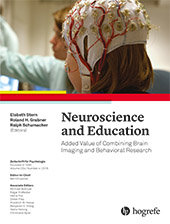Abstract
Abstract. An understanding of the relationship between emotions, cognition, and learning can provide insight into learning needs for children with autism spectrum disorder (ASD). This article discusses current research and new theories on ASD from three different perspectives: the behavioral sciences, neuroscience, and education. The rapid increase of ASD diagnoses in children worldwide, and an understanding of autism as one of the developmental disorders affecting a spectrum of neural networks in a growing brain, indicates that educational implications from the combined insights may strengthen the development of strategies and interventions not only for ASD individuals, but for neurotypical children as well.
References
(1999). The neuroanatomy of autism: A voxel‐based whole brain analysis of structural scans. Neuroreport, 10, 1647–1651. doi: 10.1097/00001756-199906030-00005
(2012). Fusiform gyrus responses to neutral and emotional faces in children with autism spectrum disorders: A high density ERP study. Behavioural Brain Research, 251, 155–162. doi: 10.1016/j.bbr.2012.10.040
(2005). Intervention and instruction with video for students with autism: A review of the literature. Education and Training in Developmental Disabilities, 40, 183–196.
(1997). Mindblindness: An essay on autism and theory of mind. Cambridge, MA: MIT Press.
(2001). The autism-spectrum quotient (AQ): Evidence from Asperger syndrome/high-functioning autism, males and females, scientists and mathematicians. Journal of Autism and Developmental Disorders, 31, 5–17.
(2011). Autism spectrum disorders: Foundations, characteristics, and effective strategies. Upper Saddle River, NJ: Pearson Education. doi: 10.1016/S0896-6273(00)80219-6
(1996). Response and habituation of the human amygdala during visual processing of facial expression. Neuron, 17, 875–887.
(2016).
A look forward . In T. A. CardonEd., Technology and the treatment of children with autism spectrum disorder (pp. 151–154). Heidelberg, Germany: Springer International. doi: 10.1007/978-3-319-20872-5. (2014). Autism and developmental disabilities monitoring (ADDM) network. Retrieved from http://www.cdc.gov/ncbddd/autism/addm.html
(2006).
Social learning and social cognition . In Y. MunakataM. H. JohnsonEds., Processes of change in brain and cognitive development: Attention and Performance, XXI (pp. 249–274). Oxford, UK: Oxford University Press.(2001). Mind blindness and the brain in autism. Neuron, 32(6), 969–979. doi: 10.1016/S0896-6273(01)00552-9
(2003). Autism: Explaining the enigma (2nd ed). Oxford, UK: Blackwell Publishing. doi: 10.1093/actrade/9780199207565.001.0001
(2002).
Responsiveness to intervention: An alternative approach to the identification of learning disabilities . In R. BradleyL. DanielsonD. P. HallahanEds., Identification of learning disabilities: Research to practice (pp. 467–519). Mahwah, NJ: Erlbaum.(2001). Including children with autism in general education classrooms a review of effective strategies. Behavior Modification, 25, 762–784. doi: 10.1177/0145445501255006
(2010). Self-related awareness and emotion regulation. NeuroImage, 50, 734–741. doi: 10.1016/j.neuroimage.2009.12.089
(2011). Implications of affective and social neuroscience for educational theory. Educational Philosophy and Theory, 43, 98–103. doi: 10.1111/j.1469-5812.2010.00713.x
(2002). Soziale Kompetenz
[Social competence] . Zeitschrift für Psychologie, 210, 164–174. doi: 10.1026/0044-3409.210.4.164(2016). Altered resting state network dynamics in youths with Autism Spectrum Disorder. Experimental Brain Research, 234, 3425–3431. doi: 10.1007/s00221-016-4737-y
(2016). Comparison of fear and anger cue processing in children on autism spectrum and neurotypical peers: An EEG study. Manuscript submitted for publication.
(2007). Examining effective intervention practices for communication impairment in autism spectrum disorder. Exceptionality, 15, 233–247. doi: 10.1080/09362830701655782
(2008). On the relationship between emotion and cognition. Nature Reviews Neuroscience, 9(2), 148–158. doi: 10.1038/nrn2317
(2011). Enhanced therapeutic interactivity using social robot Zeno. In Proceedings of the 4th International Conference on Pervasive Technologies Related to Assistive Environments, 57. New York, NY: ACM. doi: 10.1145/2141622.2141690
(2006). Social Stories™ for children with disabilities. Journal of Autism and Developmental Disorders, 36, 445–469. doi: 10.1007/s10803-006-0086-1
(2007).
Emotions and their effect on adult learning: A constructivist perspective . In S. M. NielsenM. S. PlakhotnikEds., Proceedings of the Sixth Annual College of Education Research Conference: Urban and International Education Section (pp. 108–113). Miami, FL: Florida.(2003). Inclusion of learners with autism spectrum disorders in general education settings. Topics in Language Disorders, 23(2), 116–133. doi: 10.1097/00011363-200304000-00005
(1996). Face preference at birth. Journal of Experimental Psychology: Human Perception and Performance, 22, 892–903. doi: 10.1037/0096-1523.22.4.892
(2006). Predicting autism spectrum quotient (AQ) from the systemizing quotient-revised (SQ-R) and empathy quotient (EQ). Brain Research, 1079, 47–56. doi: 10.1016/j.brainres.2006.01.012



